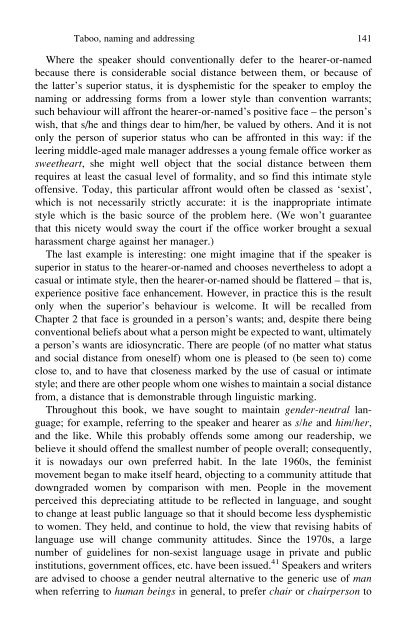Forbidden Words: Taboo and the Censoring of Language
Forbidden Words: Taboo and the Censoring of Language
Forbidden Words: Taboo and the Censoring of Language
Create successful ePaper yourself
Turn your PDF publications into a flip-book with our unique Google optimized e-Paper software.
<strong>Taboo</strong>, naming <strong>and</strong> addressing 141<br />
Where <strong>the</strong> speaker should conventionally defer to <strong>the</strong> hearer-or-named<br />
because <strong>the</strong>re is considerable social distance between <strong>the</strong>m, or because <strong>of</strong><br />
<strong>the</strong> latter’s superior status, it is dysphemistic for <strong>the</strong> speaker to employ <strong>the</strong><br />
naming or addressing forms from a lower style than convention warrants;<br />
such behaviour will affront <strong>the</strong> hearer-or-named’s positive face – <strong>the</strong> person’s<br />
wish, that s/he <strong>and</strong> things dear to him/her, be valued by o<strong>the</strong>rs. And it is not<br />
only <strong>the</strong> person <strong>of</strong> superior status who can be affronted in this way: if <strong>the</strong><br />
leering middle-aged male manager addresses a young female <strong>of</strong>fice worker as<br />
swee<strong>the</strong>art, she might well object that <strong>the</strong> social distance between <strong>the</strong>m<br />
requires at least <strong>the</strong> casual level <strong>of</strong> formality, <strong>and</strong> so find this intimate style<br />
<strong>of</strong>fensive. Today, this particular affront would <strong>of</strong>ten be classed as ‘sexist’,<br />
which is not necessarily strictly accurate: it is <strong>the</strong> inappropriate intimate<br />
style which is <strong>the</strong> basic source <strong>of</strong> <strong>the</strong> problem here. (We won’t guarantee<br />
that this nicety would sway <strong>the</strong> court if <strong>the</strong> <strong>of</strong>fice worker brought a sexual<br />
harassment charge against her manager.)<br />
The last example is interesting: one might imagine that if <strong>the</strong> speaker is<br />
superior in status to <strong>the</strong> hearer-or-named <strong>and</strong> chooses never<strong>the</strong>less to adopt a<br />
casual or intimate style, <strong>the</strong>n <strong>the</strong> hearer-or-named should be flattered – that is,<br />
experience positive face enhancement. However, in practice this is <strong>the</strong> result<br />
only when <strong>the</strong> superior’s behaviour is welcome. It will be recalled from<br />
Chapter 2 that face is grounded in a person’s wants; <strong>and</strong>, despite <strong>the</strong>re being<br />
conventional beliefs about what a person might be expected to want, ultimately<br />
a person’s wants are idiosyncratic. There are people (<strong>of</strong> no matter what status<br />
<strong>and</strong> social distance from oneself) whom one is pleased to (be seen to) come<br />
close to, <strong>and</strong> to have that closeness marked by <strong>the</strong> use <strong>of</strong> casual or intimate<br />
style; <strong>and</strong> <strong>the</strong>re are o<strong>the</strong>r people whom one wishes to maintain a social distance<br />
from, a distance that is demonstrable through linguistic marking.<br />
Throughout this book, we have sought to maintain gender-neutral language;<br />
for example, referring to <strong>the</strong> speaker <strong>and</strong> hearer as s/he <strong>and</strong> him/her,<br />
<strong>and</strong> <strong>the</strong> like. While this probably <strong>of</strong>fends some among our readership, we<br />
believe it should <strong>of</strong>fend <strong>the</strong> smallest number <strong>of</strong> people overall; consequently,<br />
it is nowadays our own preferred habit. In <strong>the</strong> late 1960s, <strong>the</strong> feminist<br />
movement began to make itself heard, objecting to a community attitude that<br />
downgraded women by comparison with men. People in <strong>the</strong> movement<br />
perceived this depreciating attitude to be reflected in language, <strong>and</strong> sought<br />
to change at least public language so that it should become less dysphemistic<br />
to women. They held, <strong>and</strong> continue to hold, <strong>the</strong> view that revising habits <strong>of</strong><br />
language use will change community attitudes. Since <strong>the</strong> 1970s, a large<br />
number <strong>of</strong> guidelines for non-sexist language usage in private <strong>and</strong> public<br />
institutions, government <strong>of</strong>fices, etc. have been issued. 41 Speakers <strong>and</strong> writers<br />
are advised to choose a gender neutral alternative to <strong>the</strong> generic use <strong>of</strong> man<br />
when referring to human beings in general, to prefer chair or chairperson to

















